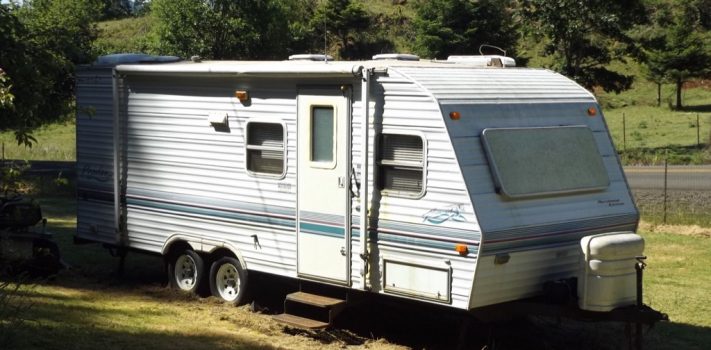As a lifetime Prepper, I’m always looking at ways to improve the odds of surviving, whatever may come my way. I readily admit that no one, no matter how rich they may be, can prepare for every circumstance that may come along, that demands survival. I remember back in school, in the early 1960s, when we practiced “duck and cover” as a way of surviving a nuke going off in our city. Even back then, it was silly to believe that by ducking under your desk while in school would add to your survival chances. Our school was huge – three stories, and a full basement. We learned to head to the basement if alerted that a nuke was about to go off…and we found inside walls, and we sat facing those walls, with our hands and arms protecting us. Again, not feasible, but still better than ducking under a desk. My plan was to run across the street, to the house we lived in. Beyond that, I had a vague plan to go and shelter in the storm drain under the sidewalk in front of our house.
There is no sure way we can prepare for all the nasty things that we might have to endure – simple as that! We have always kept tents in our vehicles, along with sleeping bags, and a small e-box – that contained food, water, and other survival necessities, and we still do to this day. However, while none of that is exactly what we want, it is better than nothing. If we had to evacuate our home, we’d of course grab our BOBs (Bug Out Bags) along with weapons and whatever else we could grab and go within a few minutes. Not a bad plan, but not a good one.
Enter the world of RVs – Recreational Vehicles. In this article, I use the term RV generically to include motor homes as well as travel trailers, camping trailers, and 5th wheel trailers. We own a fairly nice, used, 22-foot travel trailer, and it has everything we’d need for survival. We keep it fairly well-stocked with enough food, for our family of four, at all times. If all we could do is hook up to a tow vehicle and drive away, then we’d have enough food for several months, for the four of us. Of course, we’d top-off the freshwater tank, as well. Given a little more time – say an hour or so, we could add a lot more food inside our vehicle and trailer, and of course more weapons and lots of ammo. We have several bug-out locations we could go to – or at least attempt to get to one of them. Once again, not a perfect plan, but better than no plan, like jumping in a vehicle and just driving off.
Prior to 2008, there were a lot of really nice used travel trailers, and if you’ll recall, that is when the recession hit, and those people who lost jobs, purchased some used travel trailers. In our area – all around our area – we would see travel trailers, and 5th wheels alongside the mountain roads in our area, where people were living – and I mean, these rigs were right alongside mountain roads – not a pull-off or a campground. It was a heart-breaking sight, to say the least. We even saw people with RVs, set-up in friends’ or families’ front yards. Some were living in small tents – Ugh! However, better than living on the streets.
Our Little Home on Wheels
As you can see in the photos accompanying this article, our 22-foot travel trailer isn’t too big, nor too small – more on this later. It is an older model, manufactured in 1999. However, inside and out, it is almost like new. Many people purchase RVs and trailers, with the idea of seeing the country. However, when it comes down to it, most RVs, aren’t used very often. Our travel trailer was purchased with two things in mind: First, as a mobile bug out dwelling and secondly as a spare “room” for family and friends who might come to visit. Our home only has two bedrooms, and the very small one, is used as my home office. So, there are no accommodations for guests, unless we put them on the floor of the living room or on a small folding cot. Now, we can house them in the travel trailer, and some have said they loved it – couldn’t believe how nice it was inside. We live in the boonies, so it is usually very quiet at night.
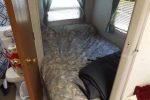 Our travel trailer can sleep seven people – well, sorta. There is a twin bed in the rear of the trailer. In the kitchen area, is a sofa and it opens-up to sleep two more people. Above that, is a single sleeping bed, and that is for a small child. The dining area – the table folds down and that area can sleep two more people. However, in reality, the sofa that converts to a bed, is best used for one person to sleep on, and the same for the dining area that converts into a bed. In a worst-case scenario, the sofa and dining bed can sleep two people each, but not recommended unless you don’t mind sleeping close together. Our travel trailer can easily sleep myself and wife, and our two daughters. The smaller sleeping area is repurposed for storing food.
Our travel trailer can sleep seven people – well, sorta. There is a twin bed in the rear of the trailer. In the kitchen area, is a sofa and it opens-up to sleep two more people. Above that, is a single sleeping bed, and that is for a small child. The dining area – the table folds down and that area can sleep two more people. However, in reality, the sofa that converts to a bed, is best used for one person to sleep on, and the same for the dining area that converts into a bed. In a worst-case scenario, the sofa and dining bed can sleep two people each, but not recommended unless you don’t mind sleeping close together. Our travel trailer can easily sleep myself and wife, and our two daughters. The smaller sleeping area is repurposed for storing food.
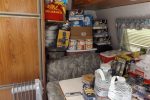 Starting from the front of the trailer, we have the dining set-up, and four people can eat meals at the same time. On one side of the dining area, is a lot of room for storing more food and other things – it looks like a mess in the photo, but it is not. We even have a small television there, that we can use for entertainment. As you walk into our trailer, you’ll see the small fridge and freezer, and depending on the size of your RV, that will be the size of these appliances – and most of the time, the fridge and freezer are very small – not much you can do about that.
Starting from the front of the trailer, we have the dining set-up, and four people can eat meals at the same time. On one side of the dining area, is a lot of room for storing more food and other things – it looks like a mess in the photo, but it is not. We even have a small television there, that we can use for entertainment. As you walk into our trailer, you’ll see the small fridge and freezer, and depending on the size of your RV, that will be the size of these appliances – and most of the time, the fridge and freezer are very small – not much you can do about that.
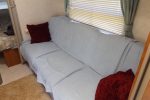
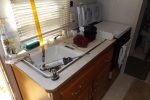 As you enter the trailer and look to your left, you’ll see the sofa that opens into a bed on one side, and across from that, is the “kitchen.” It has a small two-sink set-up, and covers, so you can cover the sink and use it as a cutting board. There is a three-burner propane stove as well as a small oven – don’t think about putting a big turkey in there, though – but it will handle a lot of things believe it or not. Next to the kitchen, is a very small clothes closet – wish it were bigger, but we have it stuffed floor to top. Next to the closet is the bathroom. Of course, it is small, but it has a stand-alone toilet, bath tub/shower and sink. In the far rear of the trailer to the right of the bathroom, is the main “bedroom.” It just has a small bed and some storage around the walls.
As you enter the trailer and look to your left, you’ll see the sofa that opens into a bed on one side, and across from that, is the “kitchen.” It has a small two-sink set-up, and covers, so you can cover the sink and use it as a cutting board. There is a three-burner propane stove as well as a small oven – don’t think about putting a big turkey in there, though – but it will handle a lot of things believe it or not. Next to the kitchen, is a very small clothes closet – wish it were bigger, but we have it stuffed floor to top. Next to the closet is the bathroom. Of course, it is small, but it has a stand-alone toilet, bath tub/shower and sink. In the far rear of the trailer to the right of the bathroom, is the main “bedroom.” It just has a small bed and some storage around the walls.
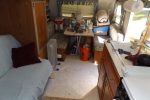
 This decent-sized trailer has two 30-pounds propane tanks. This amount of propane will last a good long time, if you only use it for cooking. The fridge/freezer can run off of propane as well as shore power. Our fresh water tank is about average size, for the size of this trailer – it holds 25-gallons of water for drinking and cooking. There are two other tanks under the trailer. One is for graywater – this is discharge water from the sinks or bath tub/shower. The other is the black water holding tank – and it is for sewage from your toilet…both of these tanks hold 25-gallons each. [JWR Adds: For any stay of more than day or two, readers are advised to be sure to use special RV toilet paper that dissolves more completely than regular TP. Otherwise, the result will be a clogged blackwater tank.]
This decent-sized trailer has two 30-pounds propane tanks. This amount of propane will last a good long time, if you only use it for cooking. The fridge/freezer can run off of propane as well as shore power. Our fresh water tank is about average size, for the size of this trailer – it holds 25-gallons of water for drinking and cooking. There are two other tanks under the trailer. One is for graywater – this is discharge water from the sinks or bath tub/shower. The other is the black water holding tank – and it is for sewage from your toilet…both of these tanks hold 25-gallons each. [JWR Adds: For any stay of more than day or two, readers are advised to be sure to use special RV toilet paper that dissolves more completely than regular TP. Otherwise, the result will be a clogged blackwater tank.]
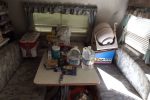 There is a propane furnace and it really heats up the entire trailer in short order, and it is forced air. Good and bad on this…this means that when you turn on the furnace, it uses the power from the two batteries to power the furnace, and in less than a day, your batteries will run down – they are deep cycle batterys. We have two generators for recharging the batteries. One of them is used to keep the batteries charged, and it is only a 1,000 amp-hour battery set…so it doesn’t use a lot of fuel. If you are dry-camping – no shore power, you can only do so much – propane gets used up quickly when the furnace is on. No easy solution to this, unfortunately.
There is a propane furnace and it really heats up the entire trailer in short order, and it is forced air. Good and bad on this…this means that when you turn on the furnace, it uses the power from the two batteries to power the furnace, and in less than a day, your batteries will run down – they are deep cycle batterys. We have two generators for recharging the batteries. One of them is used to keep the batteries charged, and it is only a 1,000 amp-hour battery set…so it doesn’t use a lot of fuel. If you are dry-camping – no shore power, you can only do so much – propane gets used up quickly when the furnace is on. No easy solution to this, unfortunately.
Back-Up Heat and Cooking
Small kerosene lanterns are carried that can placed in a couple of areas, will keep you from freezing to death, believe it or not. Not the perfect answer to staying warm. However as I said, there is no perfect set-up, when it comes to survival – you do what you need to do. We keep a solar oven in the trailer, and we can set that up for cooking on sunny days, and that saves a lot of propane. We also have a couple rocket stoves we can use to cook on. And, we have a small hand-powered washing machine for washing clothes.
There is some storage, under the front end of the trailer – not a lot of room, but you can get more in there than you’d think you can. There is a 5-gallon hot water heater, and you can easily get two showers out of one filling. Keep in mind, you have to replace any water you use, so find a spot that has fresh water, if possible. We keep several plastic water cans handy, if we have to draw water from a surface source. And of course, if that is for cooking or drinking that water, then we purify it.
No one knows what can/will happen in a survival situation. There are many very small and rural RV campgrounds that you can use – great if they have shore power. However, with no power and no water under pressure then there is no sense in paying to park there.
This is just a brief overview of how a RV or trailer can be used in a survival situation. Again, there is no perfect answer to all of our problems, but an RV or trailer can sure make surviving a lot easier. It sure beats sleeping in a tent or living on the streets. Our trailer was marked at $10,000 when we went shopping for one. That was six years ago. We ended up getting it for $5,500 – a great deal. We had previously owned another similar travel trailer, and it was set-up pretty much like the one we now own. Our current one has all the “luxuries” of home in a compact space – our’s is about 300 square feet.
Our plan is to eventually sell our small homestead in the near future. We intend to purchase either a bigger traditional trailer, or a nice used 5th wheel. With the proceeds from that sale of our house, we will buy some extremely rural land. We’d tow the trailer there, have a well and septic installed. We’ll have solar panels for power – and a battery bank for storing power. If you don’t have a home on a foundation on your land and you’re not hooked-up to any utilities, then you only pay taxes you’d owe for the land itself. Think about it.
I hope that this little primer is helpful.

